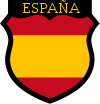
The Royal Italian Air Force (RAI) was the name of the air force of the Kingdom of Italy. It was established as a service independent of the Royal Italian Army from 1923 until 1946. In 1946, the monarchy was abolished and the Kingdom of Italy became the Italian Republic, whereupon the name of the air force changed to Aeronautica Militare.
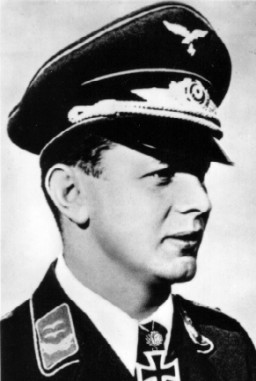
Josef "Pips" Priller was a German military aviator and wing commander in the Luftwaffe during World War II. As a fighter ace, he was credited with 101 enemy aircraft shot down in 307 combat missions. All of his victories were claimed over the Western Front, including 11 four-engine bombers and at least 68 Supermarine Spitfire fighters.

Jagdgeschwader 77 Herz As was a Luftwaffe fighter wing during World War II. It served in all the German theaters of war, from Western Europe to the Eastern Front, and from the high north in Norway to the Mediterranean.
Heinz Wimmersal Sachsenberg was a German World War II fighter ace who served in the Luftwaffe. He was also a recipient of the Knight's Cross of the Iron Cross, the highest award in the military and paramilitary forces of Nazi Germany during World War II. Sachsenberg claimed 104 aerial victories.

Anton Hafner was a German Luftwaffe military aviator during World War II and a fighter ace credited with 204 enemy aircraft shot down in 795 combat missions. The majority of his victories were claimed on the Eastern Front, but he also claimed 20 victories over the Western Front during the North African Campaign.

Emil Lang, nicknamed "Bully", was a Luftwaffe flying ace during World War II. A flying ace or fighter ace is a military aviator credited with shooting down five or more enemy aircraft during aerial combat. Lang was credited with 173 aerial victories—144 on the Eastern Front, 29 on the Western Front—and one Soviet MTB sunk in 403 combat missions.

Fritz Losigkeit was a German Luftwaffe military aviator during the Spanish Civil War and wing commander during World War II. As a fighter ace, he is credited with 68 aerial victories in approximately 750 combat missions. This figure includes 13 aerial victories over the Western Allies, the remaining victories were claimed over the Eastern Front.

Gerhard Thyben was a German military aviator who served in the Luftwaffe from 1940 until the end of World War II and later as an instructor with the Colombian Air Force. As a fighter ace, he claimed 157 enemy aircraft shot down in 385 combat missions, five of which over the Western Allies the other 152 were claimed on the Eastern Front.
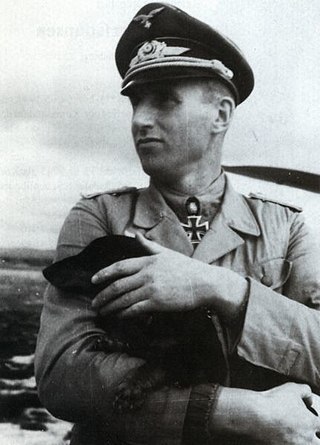
Erwin Clausen was a German Luftwaffe military aviator during World War II, a fighter ace credited with 132 aerial victories—that is, 132 aerial combat encounters resulting in the destruction of the enemy aircraft—claimed in 561 combat missions. He was "ace-in-a-day" four times, shooting down five or more aircraft on a single day.

Franz Eisenach was a German fighter ace during World War II and a recipient of the Knight's Cross of the Iron Cross of Nazi Germany. He was credited with 129 aerial victories claimed in 319 combat missions, all on the Eastern front of the Second World War.
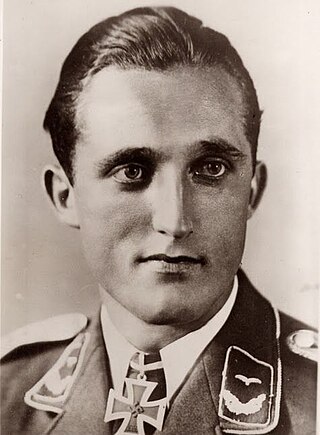
Friedrich Geißhardt was a German former Luftwaffe fighter ace and recipient of the Knight's Cross of the Iron Cross with Oak Leaves during World War II. A flying ace or fighter ace is a military aviator credited with shooting down five or more enemy aircraft during aerial combat. The Knight's Cross of the Iron Cross was the highest award in the armed forces of Germany during World War II.
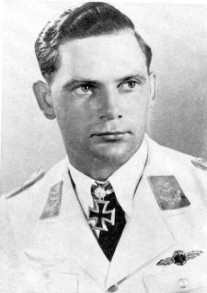
Heinrich Setz was a German Luftwaffe military aviator during World War II, a fighter ace credited with 138 enemy aircraft shot down in 274 combat missions. The majority of his victories were claimed over the Eastern Front, with six claims over the Western Front.

Albin Wolf was a German Luftwaffe military aviator during World War II, a fighter ace credited with 144 enemy aircraft shot down. All of his victories were claimed over the Eastern Front.

Karl Gratz was an Austrian-born Luftwaffe fighter pilot during World War II. As a fighter ace, he was credited with 138 aerial victories claimed in more than 900 missions. Gratz claimed the majority of his victories over the Eastern Front, and 17 over the Western Front.

Rudolf Trenkel was a German Luftwaffe military aviator during World War II. As a flying ace, he was credited with 138 victories and was a recipient of Knight's Cross of the Iron Cross of Nazi Germany.

Jakob Norz was a Luftwaffe flying ace of World War II. Norz is listed with 117 aerial victories—that is, 117 aerial combat encounters resulting in the destruction of the enemy aircraft—becoming an "ace-in-a-day" on seven separate occasions. All his victories were claimed over the Soviet Air Forces in 332 combat missions. He was also a recipient of the Knight's Cross of the Iron Cross, the highest award in the military and paramilitary forces of Nazi Germany during World War II. Norz was killed on 16 September 1944 in a forced landing following combat with a large formation of Soviet aircraft attacking Kirkenes.

Franz-Walter Woidich was a Luftwaffe flying ace of World War II. Wernitz was credited with 110 aerial victories claimed in roughly 1000 combat missions. He was also a recipient of the Knight's Cross of the Iron Cross, the highest award in the military and paramilitary forces of Nazi Germany during World War II.
The Messerschmitt Bf 109 was a German World War II fighter aircraft designed by Willy Messerschmitt and Robert Lusser during the early to mid-1930s. It was one of the first true modern fighters of the era, including such features as all-metal monocoque construction, a closed canopy, a retractable landing gear, and was powered by a liquid-cooled, inverted-V12 aero engine.

Egon Albrecht-Lemke was a German-Brazilian Luftwaffe fighter pilot and recipient of the Knight's Cross of the Iron Cross during World War II. Albrecht claimed 25 aerial victories, 10 over the Western Front and 15 over the Eastern Front.

Oskar "Ossi" Romm was a Luftwaffe ace and recipient of the Knight's Cross of the Iron Cross during World War II. The Knight's Cross of the Iron Cross was awarded to recognise extreme battlefield bravery or successful military leadership. During his career he was credited with 92 aerial victories, 82 on the Eastern Front and 10 on the Western Front.
